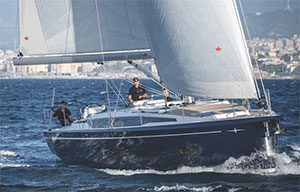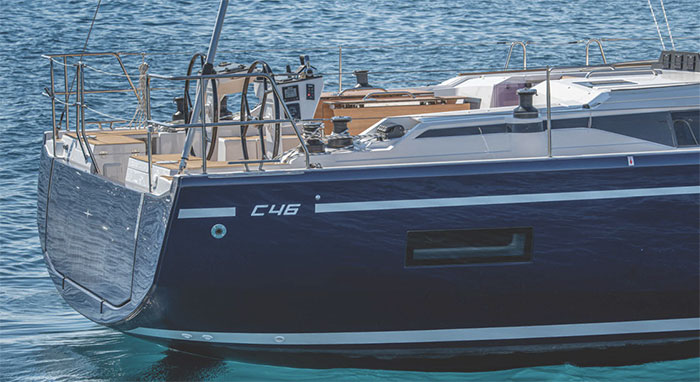

Can one yacht really satisfy a wide range of sailors? It’s a tough design brief but Bavaria and Cossutti reckon they’ve cracked it
On delivery trips between Mediterranean boat shows and on several test sails last summer and autumn, the eagerly awaited new Bavaria C46 confirmed that it meets the shipyard's specifications to the letter. The development team wanted nothing less than a 46ft sailing yacht that sails well and is easy to handle, but also is so versatile that it can be configured for a wide variety of purposes and requirements.
Perhaps as a fast and safe cruising yacht for long voyages. Or as a comfortable family boat with many cabins. Or for use as a charter yacht, or for any other purpose. Ambitious sailors will, with the appropriate sails, be able to compete successfully in regattas. In short, this yacht is the basis on which every owner can then realise their own ideas. There are a number of variations of the interior, options are possible as the individual cabins can be equipped and utilised in very different ways.
But back to the basics, the sailing characteristics. The delivery crew of only two sailed the boat from Cannes to Genoa, a stretch of 100 miles, in under 15 hours – an average of just under seven knots.
The designer’s point of view
Maurizio Cossutti explains the naval architecture of the Bavaria C46
The new C46 develops, reinterprets and expands the design and high-performance concepts at the basis of the shipyard's C-Line. Like all models in the C-Line, the C46 is the result of a collaboration between the Bavaria development team and the Cossutti Yacht Design Studio.
This is the sixth model born from the collaboration between our office and Bavaria Yachts, and it is the evolution of the concepts introduced with previous models. With the C46, the chine and Vbow concepts introduced with the Bavaria C42 and C38 have been enhanced and improved from both the naval architecture and exterior design points of view.
Bavaria’s request was to design a big and comfortable 46ft boat with an elegant and sleek appearance. For this reason we evolved the two-level deck into a more classic design that allows it to be lower at the bow, satisfying the required standing heights, in particular in front of the mast. In this way the eye is able to “run free” from bow to stern without any bumps or interruptions.

One of the two prototypes was tested over long distances sailing shorthanded
The sheerline is an evolution of the previous models, giving the chamfer a complex shape that changes height and inclination as it runs along the hull side, ending at the bow with an integrated bowsprit that gives the feeling of a longer and more elegant boat. Great attention has also been devoted to the transom design, which has been completely refined in comparison to the previous models to have a lighter appearance.
The design is of course dictated not just by aesthetics but also by the production requirement for a boat that is easy to produce and assemble. The hull shape shows a powerful bow, which is appreciated on the smaller models we designed for Bavaria, both for the additional volume on deck and below, and also for the good balance given when sailing heeled, but with a different, higher, chine position, and a more tapered and higher transom.
We designed a sailplan that ensures the optimum sailing performance, keeping in mind the well-known characteristics that a Bavaria customer wants from his boat, such as high stability and the balance of the helm. The sailplan itself is characterised by a taller mast, compared with competitors and also with the C45; the jib tracks on the coachroof allow narrower sheeting angles and a refined keel, deeper with 2.30m draught but with a lighter, slimmer bulb, add some “sportiness” despite the C46 being clearly a bigger, although not heavier boat than its predecessor.
Sailing is simplified by the "Code Permanent", a large, furled reaching sail by Elvstrøm Sails. Effectively, this is a Code 0 made of lighter cloth, which can be left permanently hoisted on every trip when furled. Thanks to the tough torsion line in the luff, it can easily be furled and does not have to be set or retrieved when sailing, as it is unfurled and furled like a large genoa (the sail even has UV protection on the leech). Handling is extremely easy and gybing is also no longer dramatic, as the sail is simply furled from the cockpit before the manoeuvre and unfurled again on the new tack.

The bowsprit has a furler for a ‘code permanent’ reaching sail that can stay there for a whole season
In relaxed sailing mode the boat easily demonstrates the versatility for which she is designed, particularly the rig and the sail plan. The mast is positioned almost exactly in the centre of the boat, which ensures balanced sailing and the selftacking jib gives plenty of drive, which is clearly evident when test sailing in choppy seas off Barcelona. After tacking, the boat can immediately pick up speed again even in short, steep waves. This is impressive, increases the pleasure of sailing and is ultimately also a safety aspect. While a pro sailor can get top performance out of this boat, it will also sail easily with less effort. It is balanced enough to tolerate a beginner at the wheel and will not immediately punish minor steering errors with noticeable consequences.
There were a number of internal design workshops at Bavaria Yachts and also many discussions, which produced a clear specification for the designers, Maurizio Cossutti and Alessandro Ganz. After all, this new Bavaria should not only be fast and sail well, but also be easy to handle for a large or small crew and even for sailing singlehanded. It took a long time to fine-tune the concept and come up with the many detailed solutions that in the end completely fulfilled the design brief.

A large foretriangle gives ample space for a powerful self-tacking jib with a usefully tight sheeting angle
One central aspect is the winch layout of the cockpit. A maximum of six winches ensure full versatility. Two winches, one on each side at the helm stations, make it easy to sail the boat from here, where both the mainsail and headsail sheets are close to hand. However, when manoeuvring with a full crew, the space by the helm can become a little tight, so there is the option of placing an additional winch on each of the cockpit coamings in the traditional way. The headsail sheets can be redirected so that they can be operated from here as well as from the helm positions. Similarly, any of the halyards, which are all led aft to the cockpit, can be operated from any winch. And of course there is the option of ordering at least two primary winches as electric winches.
The mainsail is controlled by a "German mainsheet" without a traveller: the sheet is led from the boom to the mast and from there aft into the cockpit on both sides, where it terminates on both sides on the winches at each helm station. However, there is also a simple variation here: if you turn the sheet around and attach the loose ends to the boom, you have an "endless sheet" in the cockpit, and a double sheeting system with which each side of the sheet can be adjusted individually and the boom can be trimmed very accurately. An additional plus is gybing in strong winds, where the boom can be sheeted amidships in a very controlled manner, held by both sheets, and then slowly paid out again on the new tack.
 A closed stern with stowage box, helm seats and fold-down bathing platform
A closed stern with stowage box, helm seats and fold-down bathing platformIn general, this is a cockpit for sailing, which is not immediately obvious at first glance thanks to the large tables and comfortable cockpit benches. But then you notice where the instruments are mounted, clearly visible to everyone above the companionway, with repeaters on the side of the steering pods for the eyes of the person helming. Anyone who steers the boat has a very comfortable space from which to do so. Unlike some modern yachts, you are not standing all the way aft in the open stern, only protected from going overboard by a thin wire. Two solid and large stowage boxes behind the helm stations not only provide additional seating (not just on the side deck) but also a reassuring feeling of safety.

The ‘German mainsheet’ can easily be re-reeved as a double sheeting system
Speaking of the stern, there is a large, fold-out bathing platform here. Behind it is storage space for all the wet and sandy stuff from swimming, snorkelling and so on. There is also plenty of storage space in the cockpit itself, even for the loose ends of the sheets behind the winches. The tables are solid to hold on to and lean against, and there is a nice little detail worth mentioning here: the retractable ambient lamps for a romantic evening in the cockpit.
More importantly, for safety there is access to the steering quadrant directly under the cockpit floor between the helm stations. Everything is at hand there, the autopilots as well as the attachment for an emergency tiller. For reasons of space, this points aft when in use, but it has eyelets at the end, with corresponding eye-bolts in the cockpit (also for the helmsman to clip on the harness), so you can rig a tackle as a steering aid.

It’s easy to trim all sails from the helm
For practical testing, two prototypes – the first two production boats – were set up and the sails and rig configurations were extensively trialled and tested on boat one, by specialists from Elvstrøm Sails and Seldén Masts. The second boat, on the other hand, was allowed to sail longer trips back and forth between the different Mediterranean boat shows, 100 miles from Cannes to Genoa and then 350 miles from Genoa to Barcelona. Such deliveries are particularly demanding practical tests, as they are usually carried out with a minimal crew in a very limited time. And then the boat also has also to be presented in perfect condition at another boat show afterwards...
After the boat show in Barcelona, the Bavaria C46 passed another test. Eleven journalists from 11 countries thoroughly scrutinised the boat as part of the selection process for the European Yacht of the Year award. All were impressed by the boat and their feedback confirmed that Bavaria Yachts will continue to set trends in the market with the new Bavaria C46.
‘The Bavaria C46 is not a reinvention of the boat, but a small quantum leap for us as a boatyard thanks to a very good and well thought-out development and some really innovative ideas,’ says Marcus Schlichting from Bavaria Yachts.
Click here for more information on Bavaria Yachts »
We invite you to read on and find out for yourself why Seahorse is the most highly-rated source in the world for anyone who is serious about their racing.
To read on simply SIGN up NOW
Take advantage of our very best subscription offer or order a single copy of this issue of Seahorse.
Online at:
www.seahorse.co.uk/shop and use the code TECH20
Or for iPad simply download the Seahorse App at the iTunes store


